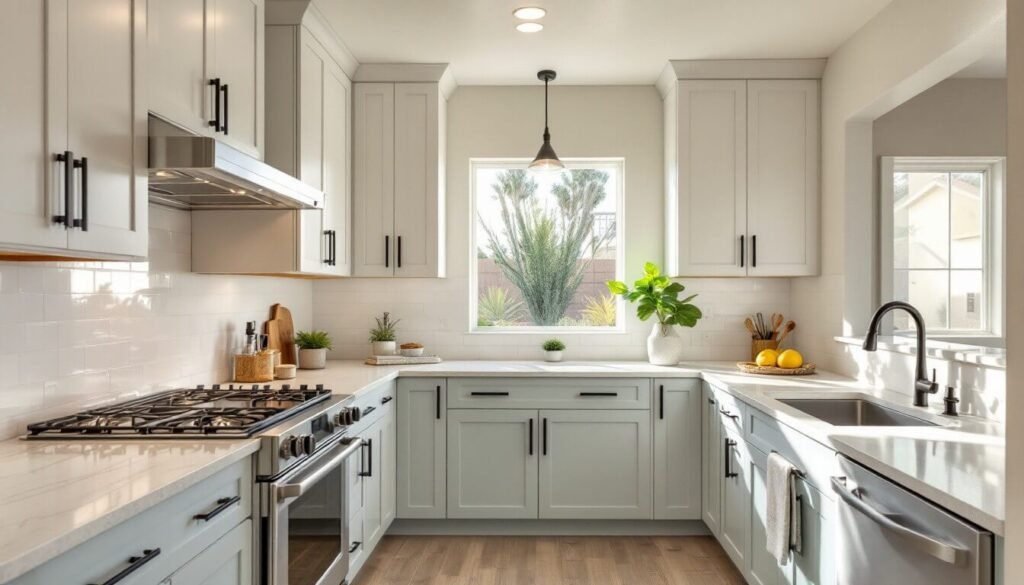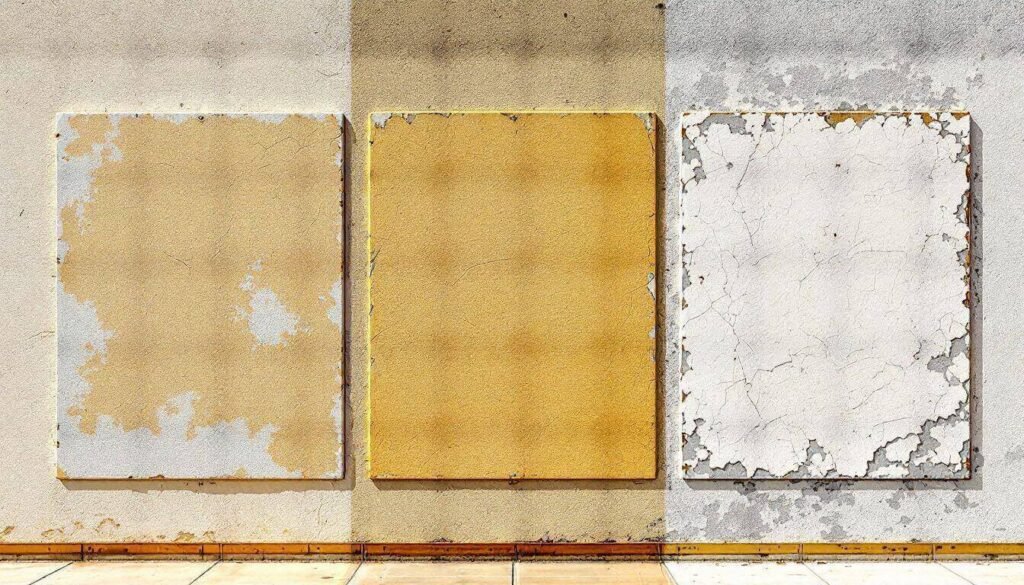How Often Should You Repaint Stucco Homes in Phoenix?
Stucco Durability in Phoenix
Phoenix homeowners know the desert sun takes a toll on everything it touches, and stucco is no exception. Your home’s exterior deals with relentless UV rays, dust, and dramatic temperature swings that can wear down even the best paint. That’s why fresh paint is about more than a fresh exterior aesthetic; it’s your first line of defense against fading, cracking, and moisture creeping into your walls.
Most stucco homes in Phoenix need fresh paint every 5 to 7 years, but the rule isn’t set in stone. Surfaces with heavy sun exposure, like south and west-facing walls, may need attention as soon as every 3 to 5 years. Other factors matter, too. Monsoon storms, dust buildup, and the quality of your last paint job all play a part in how long your exterior stays protected and attractive.
It’s worth considering all these details, plus regular cleaning and repairs, to guard your investment and keep your property looking sharp. At Phoenix Pro Painters, we pair local expertise with your needs to ensure you get your painting project done in a way that’s tailored to this area’s harsh climate. If you’re interested in tips for a longer-lasting finish or want to learn more about the repainting process, keep reading.
Phoenix’s Climate and Its Effect on Stucco Paint
Phoenix’s desert climate delivers extreme sunlight, triple-digit heat, swirling dust, and fierce monsoon storms. These factors combine to challenge the life and look of stucco paint more than in most places. To keep stucco protected and beautiful, understanding how this climate affects paint is key to maintaining any home in Phoenix.
How Sun Exposure Speeds Up Paint Wear
The Arizona sun is relentless. Daily exposure to strong ultraviolet (UV) rays breaks down the chemical bonds in paint, damaging both pigments (color) and binders (the material that holds paint together). This process fades the color and weakens the paint surface so it peels or chalks sooner. In Phoenix, exterior walls facing direct sunlight, especially to the west or south, see the worst of it.
Walls that spend all day soaking up the sun can lose half their paint life compared to shaded sides. For example, a west-facing stucco wall may need repainting every 3 to 5 years, while a shaded area could last up to 7 or 8 years. The solution? Use UV-resistant paint designed for harsh sun. These paints stay brighter and last longer, costing a bit more up front but saving you from frequent repaints.
Impact of Heat and Dust on Stucco Surfaces
Beyond sunshine, Phoenix’s high temperatures bake paint, making it brittle. When the surface heats up day after day, tiny cracks can form, making the paint more vulnerable to peeling or letting water sneak in. Then comes the dust. Frequent dust storms leave a fine layer on every surface. If that dust mixes with rare rain or the infamous summer monsoons, it can trap moisture right next to your stucco, encouraging further damage.
When cracked or poorly sealed paint lets in moisture, monsoon rains can worsen the problem, finding their way into the wall and triggering bigger cracks or even stucco failure. That’s why a tight, well-sealed paint job is crucial for protecting your home from the elements. Cleaning dust off regularly and choosing a quality sealant with your exterior paint helps guard against these local hazards and keeps your home looking sharp.
How Often to Repaint Your Stucco Home
Maintaining the beauty and protection of your stucco home in Phoenix starts with knowing how often to repaint. While stucco stands up well to Arizona’s sun and shifting weather, paint still needs freshening up to keep your exterior resilient and sharp. Understanding the expected repaint cycle, as well as the factors that can speed up or slow down paint aging, can save you time, hassle, and money.
General Timeline for Repainting
For most stucco homes in Phoenix, repainting every 5 to 7 years is the standard. Stucco holds paint better than wood or siding, thanks to its textured surface and ability to bond tightly with paint. But desert conditions push those limits: intense sunshine, high temperatures, and dust storms all work against your home’s finish over time.
Quality matters. Many homeowners turn to elastomeric paints for longer life. These coatings stretch and contract as the stucco shifts with temperature changes, reducing the risk of cracking and peeling. Elastomeric options may push your repainting schedule to the longer end of the timeline, sometimes 8 years or more with good care. Still, no paint is invincible in the Phoenix heat, so steady maintenance and periodic checks are key no matter your paint choice.
Factors That Change the Schedule
Several other factors affect how often your stucco needs repainting. While the 5 to 7 year window is a solid baseline, the details of your home and your upkeep play a major role.
- Paint Quality: A premium paint or a specialized coating like elastomeric or acrylic will typically last longer than discount brands. For Phoenix exteriors, products designed for sun and weather resistance extend the timeline.
- Age of Your Home: Newer homes or freshly refinished stucco need attention sooner. Stucco takes a few years to fully cure, and the first coats of paint may not bond as tightly as follow-up coats. Older homes, especially those with lingering cracks, require more frequent inspection.
- Orientation: Walls facing south or west get hammered by direct sunlight daily. These sides often show fading, chalking, and peeling before the rest of the house. For example, if your west wall starts peeling in year four, you may need to prioritize that area sooner than other sides.
- Care Routine: Regularly washing off dust with a garden hose, fixing small cracks fast, and trimming bushes away from walls protects your paint investment. Skipping prep before painting (like not cleaning old paint or failing to patch cracks) causes new paint to fail more quickly than it should.
A homeowner who ignores yearly maintenance may find paint brittling and flaking by year three, while those who keep an eye on their exterior and use quality paint could enjoy a like-new finish into year seven or beyond. Good care habits truly do stretch the life of your paint. To plan your next exterior painting project, check out the exterior painting service page and schedule a free estimate.
Signs It’s Time for a Fresh Coat
Even if it’s not yet five years since your last paint job, stucco doesn’t always follow a set schedule. Knowing what to look for can help you spot early warning signs before small issues become big repairs. These visual clues often appear long before actual water damage or larger cracks do. Acting early keeps your home looking sharp and saves time and money on repairs later.
Fading and Uneven Color
One of the first signs to watch for is fading. Phoenix’s sun can quickly wash out rich or deep paint colors, turning them pale or uneven. If you notice your home no longer matches its original shade or looks dull after a good cleaning, the UV rays may have broken down the paint’s pigment. South and west-facing sides usually lose color first.
Chalking: Dusty Film or Residue
Run your hand along the stucco and see if it leaves a powdery residue. This chalky film develops when binders in the paint break down from sun exposure. Not only does this make your home look older, but it also signals that the paint is losing its ability to stick and protect the stucco underneath.
Cracking, Peeling, and Blistering
Paint should provide a solid, flexible seal over stucco. When you see cracks or areas where the paint is peeling away from the wall, it means the barrier has failed. Blisters or bubbles often show up after a rain followed by strong sunshine. These are warning signs that the paint isn’t keeping moisture out and needs attention soon.
Common trouble spots:
- Window and door frames
- Bottom edges of walls
- Areas hit hardest by the afternoon sun
Efflorescence and Staining
White, powdery streaks or stains often point to water sneaking into or behind the stucco, dissolving salts that migrate to the surface. These stains don’t just look bad. They can mean that moisture is pushing through, which slowly damages both paint and stucco.
Hairline Cracks in the Stucco
Tiny cracks in the stucco itself can be a sign that the paint and sealer are no longer doing their job. While hairline cracks are normal as homes settle, they become a concern if you see more popping up or if they run longer and start to widen. Addressing these right away with fresh paint and proper sealing heads off bigger problems.
When in Doubt, Choose a Pro Inspection
Sometimes it’s hard to judge with an untrained eye. If you’re unsure, an expert can review all surfaces and help you decide if repainting is needed. Professionals can spot early damage, suggest the most durable paints, and check for hidden trouble.
Catching these signs early is key to preventing more expensive problems and keeping your Phoenix stucco home protected year after year.
Tips for Keeping Your Paint Job Lasting Longer
Keeping your stucco paint looking new in Phoenix takes more than quality paint. The dry climate, harsh sun, and dust storms all add up. Routine care makes a clear difference. By following a few proven steps, you can stretch the years between full repainting and keep your home looking sharp.
Start With Proper Surface Prep
Before painting begins, a good cleaning is a must. Dust and chalky residue keep paint from sticking and lead to early peeling. Wash your stucco with a gentle power wash or scrub using a stiff brush and water.
Repair small cracks and chips before painting. Use a high-quality stucco patch and let it dry well. Unrepaired cracks act like open doors for water, which weakens both paint and stucco underneath.
- Wash walls to remove dirt, spider webs, and old paint dust.
- Patch and repair all visible cracks or damaged spots.
- Let everything dry before applying primer or paint.
Use the Right Paint for Phoenix Conditions
Not all paints are made for the Arizona climate. Choose products with UV protection and elastomeric formulas, designed to flex with expanding and contracting walls.
Apply a quality primer to bare stucco or repaired spots first. Primer improves paint bonding and covers any patchwork, so the final color looks even.
Stick to Regular Cleaning
Phoenix dust can settle on any surface overnight. Built-up dirt and organic stains eat away at paint over time. Schedule light cleanings with a hose two or three times a year, especially after big dust storms or monsoon rains.
Pay attention to shaded or damp areas where dust may stick more. Removing dirt early keeps the paint’s protective layer intact longer.
Quick cleaning checklist:
- Spray walls lightly with water to remove dust.
- Spot clean stains or bird droppings as soon as they appear.
- Trim back shrubs so branches don’t rub the paint.
Maintain Caulking and Sealant
Gaps around windows, doors, and pipes allow water and dust to sneak in. Inspect caulking every year and reapply as needed to keep a tight seal. Replace any cracked or shrunk caulk right away.
Elastomeric caulks are flexible and handle the Phoenix heat or cold without splitting, lasting much longer than cheaper products.
Tackle Small Problems Early
Don’t let little problems wait. Even a tiny paint bubble or hairline crack can let in moisture. Catching issues early makes a big difference in your paint’s lifespan.
Inspect your home at least twice a year. If you find loose paint, touch it up or repaint the area right away with leftover paint. This stops trouble from spreading.
Protect Vulnerable Areas
Some spots always need more attention: the south and west sides, window sills, and near the ground. Watch for pooling water at the base of walls after rain, and adjust your landscaping or downspouts to move water away from stucco.
Install shade features like awnings or sun screens if possible. These can reduce sun exposure and slow the fading and drying of your paint.
Quick Reference: Paint Maintenance Table
Here is a simple guide to routine paint maintenance and when to check different areas:
| Maintenance Task | How Often | What to Look For |
|---|---|---|
| Wash Exterior | Every 4 months | Dust, dirt, cobwebs |
| Inspect Caulking | Every year | Cracks, separation |
| Touch-Up Paint | As needed | Chips, peeling, bubbles |
| Patch Stucco Cracks | Every year | Small cracks or holes |
| Trim Landscaping | Every 6 months | Branches near walls |
Small habits done regularly will make your paint job last and delay that next big repaint. Simple care now saves effort later, keeping your home’s color bright and its exterior protection strong.
Frequently Asked Questions
Stucco homes in Phoenix have unique demands, and homeowners often ask about maintenance, painting schedules, and common paint issues. Here are the answers to the questions we hear most often from Phoenix residents looking to protect their property.
These answers cover the basics, but every stucco home and homeowner’s routine is a bit different. Maintain your paint, address early damage, and choose quality materials for the best results in Phoenix’s challenging climate.
Wrapping Up
So, repainting stucco in Phoenix is usually worth it every 5 to 7 years, especially when you use quality paints and keep up with basic care. Watching for fading, cracks, or peeling helps you catch trouble spots early and protect your home’s curb appeal. High-quality products and the right prep work stretch that paint life even further and add lasting value.
Your house deserves to look its best and stay protected from the tough Arizona sun. The right paint job shields your investment and cuts down future repair costs. If you want a lasting finish or need trusted advice for your next project, reach out to the professionals. Your attention to maintenance today helps ensure your home’s beauty for years to come.


